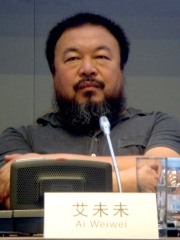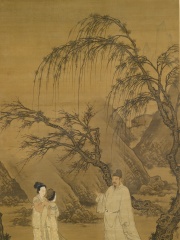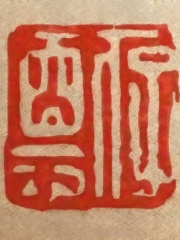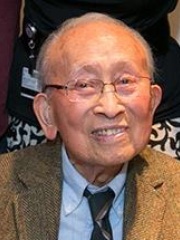



The Most Famous
ARTISTS from China
Top 5
The following people are considered by Pantheon to be the most legendary Chinese Artists of all time. This list of famous Chinese Artists is sorted by HPI (Historical Popularity Index), a metric that aggregates information on a biography's online popularity.

1. Ai Weiwei (b. 1957)
With an HPI of 66.63, Ai Weiwei is the most famous Chinese Artist. His biography has been translated into 54 different languages on wikipedia.
Ai Weiwei ( EYE way-WAY; Chinese: 艾未未; pinyin: Ài Wèiwèi, IPA: [âɪ wêɪ.wêɪ]; born 28 August 1957) is a Chinese contemporary artist, documentarian, and activist. Ai grew up in the far northwest of China, where he lived under harsh conditions due to his father's exile. As an activist, he has been openly critical of the Chinese government and its stance on democracy and human rights. He investigated government corruption and cover-ups, in particular the Sichuan schools corruption scandal following the collapse of "tofu-dreg schools" in the 2008 Sichuan earthquake. In April 2011, Ai Weiwei was arrested at Beijing Capital International Airport for "economic crimes", and detained for 81 days without charge. Ai Weiwei emerged as a vital instigator in Chinese cultural development, an architect of Chinese modernism, and one of the nation's most vocal political commentators. Ai Weiwei encapsulates political conviction and poetry in his many sculptures, photographs, and public works. Since being allowed to leave China in 2015, he has lived in Portugal, Germany, and the United Kingdom.

2. Wang Xianzhi (344 - 386)
With an HPI of 58.49, Wang Xianzhi is the 2nd most famous Chinese Artist. His biography has been translated into 15 different languages.
Wang Xianzhi (simplified Chinese: 王献之; traditional Chinese: 王獻之; pinyin: Wáng Xiànzhī; Wade–Giles: Wang Hsien-chih, 344–386), courtesy name Zijing (子敬), was a famous Chinese calligrapher of the Eastern Jin dynasty. Xianzhi was born to the Wang clan of Langya, an influential kin group descended from the Qin dynasty general Wang Jian. He was the seventh and youngest son of the famed calligrapher Wang Xizhi. Wang inherited his father's talent for the arts, and although several of his siblings were notable calligraphers, only Xianzhi was able to eventually equal his father in status, with the pair later attaining the appellation, "The Two Wangs (二王 èr wáng)." Wang Xianzhi's (also referred to as "Wang Junior" 小王) style is substantially more fluid and stylistic than that of his father ("Wang Senior" 大王), whose structural firmness nonetheless remains unrivaled. Xianzhi's most celebrated accomplishment is his refinement of the "running-cursive" script (行草), a writing style which, as the name implies, combines features of both the cursive and running scripts. The Duck-Head Pills Letter is an outstanding example of this technique. Another of Xianzhi's accomplishments is the extensive application of the "one-stroke writing" technique for (cursive script), historically (though perhaps incorrectly) attributed to Zhang Zhi (張芝) of the Late Han, which strings together several characters (typically three to four) into a single stroke or renders a complex character in a rather convoluted single stroke. Until the Tang dynasty, Wang Xianzhi's influence and reputation largely surpassed that of his father. Wang Xizhi noticed Xianzhi's talent early on and started training him in calligraphy at around the age of seven. According to one popular anecdote, Wang Xizhi once unsuccessfully tried to snatch Xianzhi's brush from behind while the latter was writing. Being amazed at Xianzhi's strong grip, Wang Xizhi remarked, "This son of mine is destined for fame!" Wang Xianzhi continued to practice diligently into adulthood until finally becoming as skilled as his father. Xianzhi died at age 42 while still in his prime. By comparison, his father did not produce many of the works he is most known for until his late forties and fifties, including the work he is most well known for (though this attribution remains controversial), Lantingji Xu (lit. 'Preface to the Poems Collected from the Orchid Pavilion'). Along with his father Wang Xizhi, Zhang Zhi and Zhong Yao, Wang Xianzhi is recognized as one of the "Four Worthies of Calligraphy (書中四賢 shūzhōng sìxián)."

3. Hu Zhengyan (1584 - 1674)
With an HPI of 57.76, Hu Zhengyan is the 3rd most famous Chinese Artist. His biography has been translated into 19 different languages.
Hu Zhengyan (Chinese: 胡正言; c. 1584 – 1674) was a Chinese artist, printmaker and publisher. He worked in calligraphy, traditional Chinese painting, and seal-carving, but was primarily a publisher, producing academic texts as well as records of his own work. Hu lived in Nanjing during the transition from the Ming dynasty to the Qing dynasty. A Ming loyalist, he was offered a position at the rump court of the Hongguang Emperor, but declined the post, and never held anything more than minor political office. He did, however, design the Hongguang Emperor's personal seal, and his loyalty to the dynasty was such that he largely retired from society after the emperor's capture and death in 1645. He owned and operated an academic publishing house called the Ten Bamboo Studio, in which he practised various multi-colour printing and embossing techniques, and he employed several members of his family in this enterprise. Hu's work at the Ten Bamboo Studio pioneered new techniques in colour printmaking, leading to delicate gradations of colour which were not previously achievable in this art form. Hu is best known for his manual of painting entitled The Ten Bamboo Studio Manual of Painting and Calligraphy, an artist's primer which remained in print for around 200 years. His studio also published seal catalogues, academic and medical texts, books on poetry, and decorative writing papers. Many of these were edited and prefaced by Hu and his brothers.

4. Tyrus Wong (1910 - 2016)
With an HPI of 49.23, Tyrus Wong is the 4th most famous Chinese Artist. His biography has been translated into 19 different languages.
Tyrus Wong (October 25, 1910 – December 30, 2016) was a Chinese-born American artist. He was a painter, animator, calligrapher, muralist, ceramicist, lithographer and kite maker, as well as a set designer and storyboard artist. One of the most-influential and celebrated Asian-American artists of the 20th century, Wong was also a film production illustrator, who worked for Disney and Warner Bros. He was a muralist for the Works Progress Administration (WPA), as well as a greeting card artist for Hallmark Cards. Most notably, he was the lead production illustrator on Disney's 1942 film Bambi, taking inspiration from Song dynasty art. He also served in the art department of many films, either as a set designer or storyboard artist, such as Rebel Without a Cause (1955), Around the World in 80 Days (1956), Rio Bravo (1959), The Music Man (1962), PT 109 (1963), The Great Race (1965), Harper (1966), The Green Berets (1968), and The Wild Bunch (1969), among others. Wong retired from the film industry in the late 1960s but continued his work as an artist, spending most of his time designing kites. He also continued to paint, sketch, and design ceramics well into his 90s. He was the subject of a 2015 documentary film, Tyrus, by filmmaker Pamela Tom (譚宇瓊). Wong died on December 30, 2016, at the age of 106.

5. Xu Li (b. 1989)
With an HPI of 39.46, Xu Li is the 5th most famous Chinese Artist. Her biography has been translated into 17 different languages.
Xu Li (simplified Chinese: 许莉; traditional Chinese: 許莉; pinyin: Xǔ Lì; born December 17, 1989, in Suzhou, Anhui) is a female Chinese freestyle wrestler who competed at the 2008 Summer Olympics and received the silver medal in the 55 kg weight class. She also placed first at the 2007 Women's Wrestling World Cup.
People
Pantheon has 5 people classified as Chinese artists born between 344 and 1989. Of these 5, 2 (40.00%) of them are still alive today. The most famous living Chinese artists include Ai Weiwei, and Xu Li. The most famous deceased Chinese artists include Wang Xianzhi, Hu Zhengyan, and Tyrus Wong.

